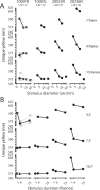Unique yellow shifts for small and brief stimuli in the central retina
- PMID: 38833255
- PMCID: PMC11156209
- DOI: 10.1167/jov.24.6.2
Unique yellow shifts for small and brief stimuli in the central retina
Abstract
The spectral locus of unique yellow was determined for flashes of different sizes (<11 arcmin) and durations (<500 ms) presented in and near the fovea. An adaptive optics scanning laser ophthalmoscope was used to minimize the effects of higher-order aberrations during simultaneous stimulus delivery and retinal imaging. In certain subjects, parafoveal cones were classified as L, M, or S, which permitted the comparison of unique yellow measurements with variations in local L/M ratios within and between observers. Unique yellow shifted to longer wavelengths as stimulus size or duration was reduced. This effect is most pronounced for changes in size and more apparent in the fovea than in the parafovea. The observed variations in unique yellow are not entirely predicted from variations in L/M ratio and therefore implicate neural processes beyond photoreception.
Figures








Similar articles
-
Effect of the S-cone mosaic and rods on red/green equilibria.J Opt Soc Am A Opt Image Sci Vis. 1998 Nov;15(11):2816-26. doi: 10.1364/josaa.15.002816. J Opt Soc Am A Opt Image Sci Vis. 1998. PMID: 9803542
-
L and M cone relative numerosity and red-green opponency from fovea to midperiphery in the human retina.J Opt Soc Am A Opt Image Sci Vis. 2000 Mar;17(3):615-27. doi: 10.1364/josaa.17.000615. J Opt Soc Am A Opt Image Sci Vis. 2000. PMID: 10708043
-
Enhanced S-Cone Syndrome: Elevated Cone Counts Confer Supernormal Visual Acuity in the S-Cone Pathway.Invest Ophthalmol Vis Sci. 2023 Jul 3;64(10):17. doi: 10.1167/iovs.64.10.17. Invest Ophthalmol Vis Sci. 2023. PMID: 37459066 Free PMC article.
-
Parallel pathways for spectral coding in primate retina.Annu Rev Neurosci. 2000;23:743-75. doi: 10.1146/annurev.neuro.23.1.743. Annu Rev Neurosci. 2000. PMID: 10845080 Review.
-
Seeing with S cones.Prog Retin Eye Res. 2001 May;20(3):255-87. doi: 10.1016/s1350-9462(00)00026-4. Prog Retin Eye Res. 2001. PMID: 11286894 Review.
Cited by
-
Asymmetric Activation of Retinal ON and OFF Pathways by AOSLO Raster-Scanned Visual Stimuli.bioRxiv [Preprint]. 2024 Dec 17:2024.12.17.628952. doi: 10.1101/2024.12.17.628952. bioRxiv. 2024. Update in: Biomed Opt Express. 2025 Jun 09;16(7):2663-2691. doi: 10.1364/BOE.566008. PMID: 39763934 Free PMC article. Updated. Preprint.
-
Novel color via stimulation of individual photoreceptors at population scale.Sci Adv. 2025 Apr 18;11(16):eadu1052. doi: 10.1126/sciadv.adu1052. Epub 2025 Apr 18. Sci Adv. 2025. PMID: 40249825 Free PMC article.
-
Asymmetric activation of retinal ON and OFF pathways by AOSLO raster-scanned visual stimuli.Biomed Opt Express. 2025 Jun 9;16(7):2663-2691. doi: 10.1364/BOE.566008. eCollection 2025 Jul 1. Biomed Opt Express. 2025. PMID: 40677827 Free PMC article.
-
Optoretinography with actively stabilized adaptive optics optical coherence tomography.Biomed Opt Express. 2025 Jul 17;16(8):3222-3236. doi: 10.1364/BOE.566376. eCollection 2025 Aug 1. Biomed Opt Express. 2025. PMID: 40809971 Free PMC article.
References
-
- Abramov, I., & Gordon, J. (2005). Seeing unique hues. Journal of the Optical Society of America A, 22(10), 2143–2153. - PubMed
MeSH terms
Grants and funding
LinkOut - more resources
Full Text Sources

